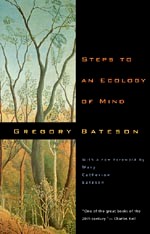
|
|
GREGORY BATESON (1904-1980) |
|
|
|
 "What pattern connects the crab to the lobster and the orchid to the primrose and all the four of them to me? And me to you?"
"What pattern connects the crab to the lobster and the orchid to the primrose and all the four of them to me? And me to you?"
- Gregory Bateson A quarter century after the death of eminent anthropologist and systems theorist Gregory Bateson, much of his work is just beginning to be fully appreciated. During his centennial year 2004 and beyond, a series of discussions, events and publications took a closer look at how Bateson challenged people to think in new ways and how his ideas continue to impact how we think in the 21st century. Gregory Bateson collaborated with Margaret Mead in Bali and New Guinea in the 1930s in developing an entirely new approach to anthropological research, using film and photography not only to document field work but also to support a new kind of analysis. The still photos and film from this landmark work of visual anthropology are already partially digitized and are available online at research universities through the Research Libraries Group or at the Library of Congress. Bateson moved away from traditional anthropology in the late 1940s, embracing psychology, behavioral biology, evolution, systems theory, and cybernetics, and working toward a theoretical synthesis he referred to as "an ecology of mind." His legacy lives on, and scholars in many different fields continue to grapple with his ideas. With the 2004 Bateson centennial, several of his books have been or will be reissued, and a number of journals have dedicated special issues to him. Bateson was one of the original trustees of the IIS and Margaret Mead's third husband. The IIS manages his literary estate, along with his pre-World War II papers at the Library of Congress, including the Bali and New Guinea photographs and film footage. The balance of his papers are housed at the University of California at Santa Cruz. Upcoming EventsThe Gregory Bateson Institute of Liege, Belgium, is sponsoring a conference on 18 and 19 November 2006, at the University of La Sorbonne, Paris. titled "Bateson - Palo Alto: The Double Bind, 50 years later."About Bateson
Special thanks to the AAA for permission to reprint Roy Rappoport's
Obituary of Gregory Bateson, an extensive look at his life work, from the June
1982 edition of American Anthropologist.
Also included in this piece was a very detailed Bibliography of Bateson's papers which we reprint here for the first time, again with permission of American Anthropologist. For a general bibliography and other Bateson material, see our Resources pages. Additional information may also be found at the Oikos website and the Global Vision site. Rodney E. Donaldson created "The Gregory Bateson Archive: A Guide/Catalog" (completed in 1987), a 2,514-page research tool which, in addition to identifying each item in the Archive, contains a detailed biographical chronology, a definitive Bibliography of the Published Work of Gregory Bateson. Read excerpts from the Guide/Catalog at the Crazy Tiger Institute website. |
|
GREGORY BATESON: Biography | Bibliography | 2004 Centennial Home | Resources | Current Projects | Margaret Mead In the Field | Frequently Asked Questions Thank you for your interest in the Institute for Intercultural Studies . We encourage you to use this website to connect to the many resources available to answer your inquiry about Margaret Mead, Gregory Bateson and their intellectual legacy. However, The Institute for Intercultural Studies, founded by Margaret Mead in 1944, has closed its doors as of December 31, 2009; no further contact information is available. For contact about permissions please see the Publishing Permission or Literary Rights section of the website. |
|
|
All rights reserved. Mead/Bateson photo ©Fred Roll.
|








